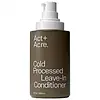What's inside
What's inside
 Key Ingredients
Key Ingredients

 Benefits
Benefits

 Concerns
Concerns

 Ingredients Side-by-side
Ingredients Side-by-side

Water
Skin ConditioningSodium Phytate
Caprylhydroxamic Acid
1,2-Hexanediol
Skin ConditioningPropanediol
SolventGlycerin
HumectantGuar Hydroxypropyltrimonium Chloride
Skin ConditioningCitric Acid
BufferingHydrolyzed Vegetable Protein
Skin ConditioningSodium Acrylate/Sodium Acryloyldimethyl Taurate Copolymer
Emulsion StabilisingPolyisobutene
Caprylyl/Capryl Glucoside
CleansingEthylhexyl Olivate
Skin ConditioningSqualane
EmollientLimnanthes Alba Seed Oil
Skin ConditioningArgania Spinosa Kernel Oil
EmollientCrambe Abyssinica Seed Oil Phytosterol Esters
EmulsifyingTremella Fuciformis Sporocarp Extract
AntioxidantBetaine
HumectantGlyceryl Caprylate
EmollientGlyceryl Undecylenate
EmollientLauryl Glucoside
CleansingPolyglyceryl-2 Dipolyhydroxystearate
Skin ConditioningParfum
MaskingWater, Sodium Phytate, Caprylhydroxamic Acid, 1,2-Hexanediol, Propanediol, Glycerin, Guar Hydroxypropyltrimonium Chloride, Citric Acid, Hydrolyzed Vegetable Protein, Sodium Acrylate/Sodium Acryloyldimethyl Taurate Copolymer, Polyisobutene, Caprylyl/Capryl Glucoside, Ethylhexyl Olivate, Squalane, Limnanthes Alba Seed Oil, Argania Spinosa Kernel Oil, Crambe Abyssinica Seed Oil Phytosterol Esters, Tremella Fuciformis Sporocarp Extract, Betaine, Glyceryl Caprylate, Glyceryl Undecylenate, Lauryl Glucoside, Polyglyceryl-2 Dipolyhydroxystearate, Parfum
Water
Skin ConditioningPentylene Glycol
Skin ConditioningCetearyl Alcohol
EmollientBehentrimonium Chloride
PreservativeLimnanthes Alba Seed Oil
Skin ConditioningDimethicone
EmollientCamellia Japonica Seed Oil
EmollientCetrimonium Chloride
AntimicrobialIsodecyl Neopentanoate
EmollientGluconolactone
Skin ConditioningSodium Benzoate
MaskingCalcium Benzoate
PreservativeSodium Hydroxide
BufferingIsopropyl Alcohol
SolventParfum
MaskingCitral
PerfumingLimonene
PerfumingLinalool
PerfumingWater, Pentylene Glycol, Cetearyl Alcohol, Behentrimonium Chloride, Limnanthes Alba Seed Oil, Dimethicone, Camellia Japonica Seed Oil, Cetrimonium Chloride, Isodecyl Neopentanoate, Gluconolactone, Sodium Benzoate, Calcium Benzoate, Sodium Hydroxide, Isopropyl Alcohol, Parfum, Citral, Limonene, Linalool
 Reviews
Reviews

Ingredients Explained
These ingredients are found in both products.
Ingredients higher up in an ingredient list are typically present in a larger amount.
Limnanthes Alba Seed Oil is the oil extracted from the seeds of the meadowfoam plant. This oil is non-fragrant and is an emollient. As an emollient, meadowfoam seed oil helps soften and hydrate the skin.
Meadowfoam seed oil is stable and has a long shelf life due to its chemical structure. It has the highest concentration of stable fatty-acids among plant oils, preventing it from degrading once exposed to oxygen.
Due to the fatty acid content, this ingredient may not be fungal-acne safe.
Meadowfoam is native to California and Oregon.
Learn more about Limnanthes Alba Seed OilParfum is a catch-all term for an ingredient or more that is used to give a scent to products.
Also called "fragrance", this ingredient can be a blend of hundreds of chemicals or plant oils. This means every product with "fragrance" or "parfum" in the ingredients list is a different mixture.
For instance, Habanolide is a proprietary trade name for a specific aroma chemical. When used as a fragrance ingredient in cosmetics, most aroma chemicals fall under the broad labeling category of “FRAGRANCE” or “PARFUM” according to EU and US regulations.
The term 'parfum' or 'fragrance' is not regulated in many countries. In many cases, it is up to the brand to define this term.
For instance, many brands choose to label themselves as "fragrance-free" because they are not using synthetic fragrances. However, their products may still contain ingredients such as essential oils that are considered a fragrance by INCI standards.
One example is Calendula flower extract. Calendula is an essential oil that still imparts a scent or 'fragrance'.
Depending on the blend, the ingredients in the mixture can cause allergies and sensitivities on the skin. Some ingredients that are known EU allergens include linalool and citronellol.
Parfum can also be used to mask or cover an unpleasant scent.
The bottom line is: not all fragrances/parfum/ingredients are created equally. If you are worried about fragrances, we recommend taking a closer look at an ingredient. And of course, we always recommend speaking with a professional.
Learn more about ParfumWater. It's the most common cosmetic ingredient of all. You'll usually see it at the top of ingredient lists, meaning that it makes up the largest part of the product.
So why is it so popular? Water most often acts as a solvent - this means that it helps dissolve other ingredients into the formulation.
You'll also recognize water as that liquid we all need to stay alive. If you see this, drink a glass of water. Stay hydrated!
Learn more about Water